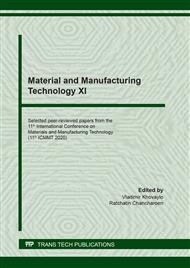p.108
p.114
p.123
p.131
p.141
p.147
p.153
p.160
p.166
Design of Small Single Cylinder 4 Stroke Spark Ignition Engine for Electric Generator with Flexible Fuel: Biogas, Liquefied Petroleum Gas (LPG) or Gasoline
Abstract:
The available of conventional fuels are fluctuating depend on distribution from the source production to consumer. The availability of biogas as renewable energy is increasing due to establishments of many organic wastes processing worldwide. The need of electricity to support daily life activity is a must, but the availability of electric source in remote area is limited especially for a farm that far away from commercial line distribution of electricity. This work is dedicated to solve this problem. The single cylinder 4 stroke spark ignition engine (83 cc) was designed to be able to be fuelled flexibly by using biogas or liquefied petroleum gas (LPG), or gasoline if sometime the biogas not available during initiation of the process or during maintenance of anaerobic digester. The engine is still can be run to provide electricity by using conventional fuel such as LPG or gasoline. The full consumption as well as emission of this flexible fuel engine was investigated. It is found that the fuel consumption is 9.97 L/mint for Biogas, 0.004 L/mint for gasoline and 2.24 L/mint for LPG. Surprisingly by using biogas the emission of carbon monoxide (CO) was down to almost zero (0.02 ppm), comparing gasoline 0.32 ppm, and LPG 0.4 ppm.
Info:
Periodical:
Pages:
141-146
Citation:
Online since:
February 2021
Authors:
Price:
Сopyright:
© 2021 Trans Tech Publications Ltd. All Rights Reserved
Share:
Citation:


